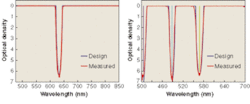In Raman spectroscopy, laser light inelastically scattered from molecules is shifted either up or down in wavelength (Stokes and anti-Stokes shifts); the shift gives information on molecular excitations. Because the Raman-scattered light is typically orders of magnitude weaker than the excitation laser light, separating the signal from the laser light is crucial for extracting useful information. One type of filter, the holographic notch filter, has seen much use for blocking laser lines in Raman spectroscopic systems.
Engineers at Semrock (Rochester, NY), however, have brought nonholographic thin-film interference filters into the limelight by refining the process for fabricating them. The result of their process improvements are thin-film notch filters that outperform holographic notch filters in the areas in which precision thin-film filters excel—high passband transmission, low temperature dependence, and the capability of operating at wavelengths of well below 400 nm (see figure).
The recently developed technology of high-precision ion-assisted, ion-beam sputtering thin-film deposition was the starting point, says Turan Erdogan, the chief technical officer of Semrock. The technology, which was developed for coating precise ferrite thin films on magnetic disk drives, extremely low-loss mirrors for ring-laser-gyroscope applications, and optical filters for dense wavelength-division multiplexing, makes possible the fabrication of thin-film filters with hundreds of layers accurately controlled by so-called "turning-point" optical-monitoring systems, says Erdogan.
"One cannot simply speak about the magnitude of the film-thickness errors, as the correlation of those errors is critical," notes Erdogan. "If the errors are purely random in nature, then one finds that to make a high-performance notch filter, the errors need to be smaller than typical atomic spacings in the materials."
The secret of a good optical-monitoring algorithm, says Erdogan, is always to have some sort of compensation. Specifically, an error that occurs in the thickness of any one layer must at least to some extent be corrected for, or compensated, by the coating algorithm when determining the proper thicknesses for the following layers. With a well-compensated algorithm, variations in layer thicknesses from the theoretically targeted layer thicknesses of as large as 1% can often be tolerated.
The Semrock engineers then developed the deposition processes for making larger-sized (up to 1 in.), shorter-wavelength (down to visible and near-UV wavelengths) optical-interference filters; developed new optical-monitoring hardware and algorithms able to control the deposition of non-quarter-wave-thick layers, particularly with thicknesses well below one quarter wave for filters at these shorter wavelengths; and developed manufacturable optical-filter designs optimized for those algorithms.
The resulting notch filters have high laser-line rejection (see figure). While very high-performance holographic filters have steeper edges and a narrower notch bandwidth, thin-film notch filters reflect rejected light straight backward, rather than diverting the rejected light at a small angle relative to the desired light, as do holographic filters. "This is the main reason why one can make a very simple, narrow-diameter, wandlike fiber-based Raman probe with thin-film filters, whereas the holographic filter–based Raman probes tend to be big, bulky boxes," says Erdogan.
Sometimes edge filters are used in Raman spectroscopy instead of notch filters; edge filters, which block the laser line along with everything else to one side of it, achieve the utmost in edge steepness, along with extremely high blocking. They allow blocking very close to the laser line, but do not allow simultaneous Stokes and anti-Stokes measurement capability, as do notch filters. Thin-film edge filters can be fabricated using the "compensation" approach; these filters have steeper edges than even high-performance holographic filters.
